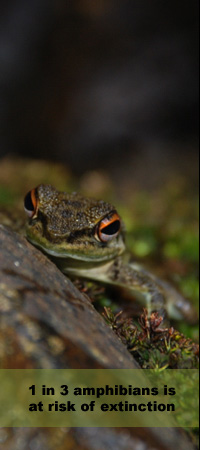|
The eggs of some amphibian species undergo direct development, otherwise the eggs of other species hatch into larvae with eyes and mouth not fully formed, and without or with rudiments of limbs. Terrestrial larvae undergo development within the egg (e.g., eleutherodactylid frog in the Caribbean).
Calls
Most caecilians and salamanders are considered voiceless. However, come species are able to create faint snapping, ticking, or popping noises. The California giant salamander (Dicamptodom ensatus) is known to produce sound via rattling and rattling.
Most anuran species produce sounds by forcing air from their lungs over vocal cords in the larynx and into sac(s) in the throat region. In general, calls of small frogs are high-itched, and those from big frog are low-pitched. Pitch, intensity, volume, frequency, and duration of call are important characteristics in finding mates.
Some frogs such as the leopard frog (Rana pipiens) or the foothill-yellow legged (Rana boylii) frog in Northern America call underwater and may rarely or never call above water.
Parental care
Overall, amphibians have a high fecundity and little or no parental care. Parental care has been reported for some species such as the gastric-brooding frog (Rheobatrachus silus) from Australia. Female of the gastric-brooding frog swallows the eggs after they are fertilized and they develop in her stomach. When fully developed into frogs, they are released through the female’s mouth.
The Strawberry Poison-dart frog (Oophaga pumilio) from Central America exhibits strong parental care as well. Once the eggs are laid, the male ensures that they are kept hydrated by transporting water. Then when eggs finally hatch into tadpoles, the female transport them on her back to suitable water-retaining location.
Amphibians as keystone and sentinel species
Amphibians play an important role in ecosystem energy flow and nutrient cycling. They allow transfer of invertebrate energy sources to predatory animals higher up to the food chain. They are both predator and prey. They are preyed by many animals including many species of reptiles (e.g., snakes), birds, and some mammals. The grazing of tadpoles transfer stored plant energy to tadpole-eating invertebrates, fish, and other vertebrates. Herbivorous tadpoles can be dominant grazers on aquatic algae, especially on small wetlands and streams.
The loss of many individuals, populations, and amphibian species is very likely to affect aquatic and terrestrial food webs, nutrient cycling, algal biomass, and insect abundance. They have an important ecological and human role.
Continue on page 3
|
|

The golden toad (Bufo periglenes) has vanished from earth since the early 1980s. © USFWS

Cane toad (Bufo marinus) is an introduced species in Australia and Hawaii. © Stewart Macdonald

A male foothill yellow-legged frog (Rana boylli) waiting for a female in California. © 2000 Pierre Fidenci
|









